
MOON PEOPLE
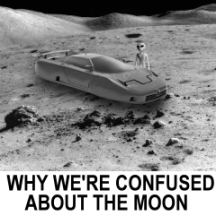
MOONS, WEEKS, DAYS
CONFUSED BECAUSE WE’RE SCATTERED INTO 24 TIMEZONES
WHAT IS A WEEK, A DAY, AND A MOON?
A week is a unit of 7 nights and days. A day is from evening to evening
experienced from whatever location one happens to be on the Earth.
A moon is
concerned with neither a week or a day, but is the complete orbital cycle of the
moon around the Earth, beginning and ending when the moon comes between the
Earth and the sun. It happens to take 697 Earth-hours, or 29.5 days, and this
orbit is not concerned with any location on the Earth, but the Earth, moon, and
sun in relation to one another.
When is the New Moon?
The
"older brother" has thousands of years' experience with this, yet newcomers
think they know better.
The new moon is 15 days before the full moon,
and is a planet-wide occurrence. Because there are 24 time zones, individual
locations experience the beginning of the first day of the moon at 24 different
times, adding to the confusion about what to look for. Add to this the
Karaite "sighted moon" rebellion that started in 767 CE,
and we have an enormous job of explaining to do.
Days and moons are separate measurements of time,
independent of one another.
With only the "greater" and "lesser" light being considered, this is devoid of
any Babylonian, Persian, Egyptian, Greek, Roman, or Gregorian viewpoint.
A MOON: There are always 29.5 "days" in the lunar cycle. This expression (29.5
days) refers to the length of time, which is approximately 697 hours. It begins
when the moon moves into position between the Earth and the sun. It has nothing
to with the time of day at any location, such as London or Sydney. Because we
live all around the Earth, our local perspective will seem to be in conflict
with others we communicate with. Yahusha is very aware of our confusion, and all
the teachers who teach their understanding to others are evidence of how
confused we are.
A DAY:
A day is from sunset-to-sunset from the perspective of one's location on the
planet. The turning of the Earth causes 12 hours of night and 12 hours of light
at the equator, and at locations north and south of the equator it varies,
except for the equinoxes, when the sun is directly above the equator twice each
year.
The moon is not involved in determining a day; only the sun.
The moon
encircling the planet has nothing to do with the
location of the observer, but rather
the moon's position relative to the Earth and Sun.
It takes the
moon roughly 697 hours to complete its orbit around the planet. The primary reason for
confusion among teachers is this: we are scattered across the planet and base
much of what we teach on
what we see from our location. When the
moon comes between the Earth and the Sun, it begins once again to build its
light.
From the perspective of the whole Earth, a day takes 48 hours to end completely,
since from where it begins (by convention) until it ends for any one location
takes 24 hours.
Each
hour west of any location the same "day" is beginning anew. Thus, even 23 hours
after a "day" begins, that same "day" is just beginning for others.
A new moon is not determined by those various locations "sighting" a sliver at
their sunset, but rather occurs for the entire Earth at once. The moon centers
itself between the Sun and the Earth, then begins to build the light of the
first day (from zero-light). After a period of 24 hours, the 1st day is fully
built, and people see the fully-built first day as a sliver when they look to
the west near sunset at their location. A "day" is for each location, but a
"moon" is for the whole Earth, not connected to any one location people may be,
or what time of the day it may be for their location. This is why there is so
much confusion, everyone is doing what seems to be right "in their own eyes".
But, we are in captivity (dispersed), and must overcome difficulties and love
one another in spite of how off we may be in our understanding.
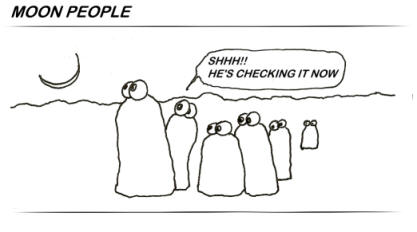
Picture yourself on the surface of the Earth, aligning your view of the moon
from the dotted lines in the
illustrations below. The moon will appear to you as the image in the outer ring.
The circuit of the moon as it travels around the Earth is illustrated by the
inner ring.
The Earth is independently spinning, and people at various locations
on the surface are arguing about what "day" of the moon it is, relative from
their position, instead of the moon in its circuit. Regardless of where
someone is, after 697 hours of time, the moon will return to its starting
position between the Earth and the sun.
Where you happen to be on the sphere of the Earth, and what time it may be at
your location, has nothing to do with when the moon reaches its zero-point.
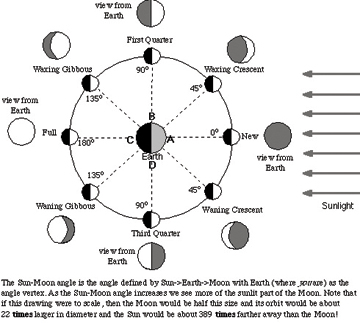
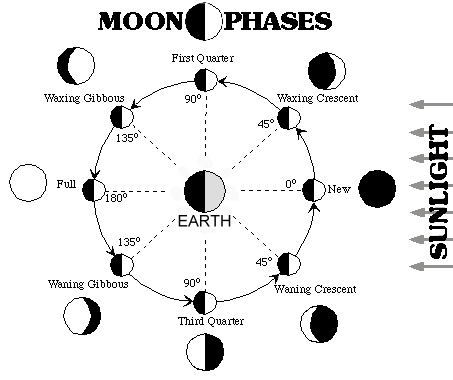
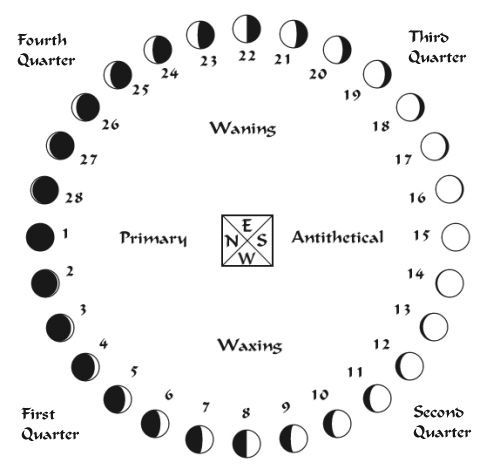
THERE’S A GOOD REASON IT’S CALLED “LOONEY”
The confusion about what day it is, and the day of the moon, is caused
by our locational perception of reality.
Most everyone hears a date,
and automatically thinks that date is everywhere all at the same
time for everyone.
Reality is completely different than what we perceive it to be for others.
This is because we are scattered across the
surface of the Earth, and call a “date” according to where we
are located, and when that day begins for us.
A “day” or date as we perceive it may be completely different for a person
in another location.
One person may live in Australia, and being close to the “International Date
Line” (a human convention), and his “day” will begin at midnight
(erroneously).
But even if he recognized the day begins at evening, it will be 24 hours
before that “day” comes to an end.
That same “day” he is in will begin for someone else living to his west, an
hour later. Another 24-hour period begins for that person. Each hour that
passes, that same day begins for each person to the west.
After 24 beginning points, that day continues on, and on, until finally
ending 48 hours after it began!
A new moon is an event when the moon centers itself between the Earth and
the Sun.
It is not related to any location on the Earth, but rather the Earth as a
whole.
It is not concerned with what time it may be for a particular person, or
even whether it is night or day for any of us.
It will take the Moon 29.5 Earth-days, or 697 Earth-hours, to arrive back at
its starting-point.
As we describe a date such as “March 20th at
sunset,” there will be 24 different versions of this
event because of all the time zones.
For someone 23 hours to the west, that very same event will only be the
beginning point for their “day.”
They’ll use the same designation for it as the person did who lives 23 hours
to their east.
A day is measurement of the complete rotation of the Earth relative to the
Sun, and the Moon is not involved at all.
A day is a rotation, not an orbit.
A month is an orbit, not a rotation.
If anyone can see a sliver, or crescent to the west at sunset where they
live, they are looking at the amount of light built-up on the Moon’s
face that represents the light of the completed “first day” of a renewed
moon.
At that point they may safely know they are now experiencing the second day
of the month. The moon will set in the west as the second day progresses.
Each night at sunset the Moon will take longer to set behind the Sun’s
setting, building the area of illumination with each night.
After another 14 sunsets from the first sighting of the crescent, it will be
the beginning of the 15th day of the Moon.
The Moon’s face will be 100% full.
That's the way the Moon appeared the night Yahuah led the children of
Yisharal out of Mitsrayim (Egypt). Once again, we're in captivity.
We'll remain so until Yahusha returns to re-gather us.
We're mixed-up because we're not home; we are scattered.
We have to love one another in spite of how we perceive one another to be.

Days and moons are independent of one another. It takes 697 hours for the moon
to complete one circuit around the Earth.

Since Yahusha never mentioned a correction for the week as different from
the Yahudim to align with the moon phases, so we have to conclude that there
has been a change in the 7-day week since Yahusha walked on the Earth. When
and where did this alteration occur, and who made it so successful that
every culture on the planet adopted it and yet all managed to inherit their
term for the 7th day based on the Hebrew word “Shabath?”
108 languages use their name for the 7th day based on the Hebrew.
When the indigenous tribes of north and
south America encountered missionaries and colonizing explorers for their
first contact with the west civilization, it was discovered they had a 7-day
weekly cycle, and the 7th day they rested. Moons were a separate measurement
cycle, just as we see the Yahudim observing today.
The “fifty days” count from Bikkurim to
Shabuoth is the sum total for seven shabua, with the morrow after the
seventh Shabath added (Uyiqra/Lev. 23).
This model is also reflected for the
calculation to Jubilees, the 50th year, summing the seven times seven shemitah cycles.
The pattern of repeating sevens is impossible to ignore for the week in the
count to Shabuoth (weeks), as well as the count to the Jubilee.
Yahuah used manna to indicate the Shabath,
not the moon. When we lose the proper Shabath, we lose
the sign of the eternal Covenant.
"What happens in the next day stays in the next day." - Adam White (spoken very
resolutely indeed)
"When Yahusha returns, He will be more interested in how we treated one another,
than how we understood the moon." - Lew White









